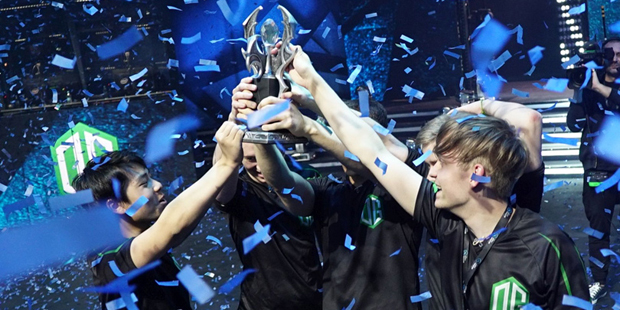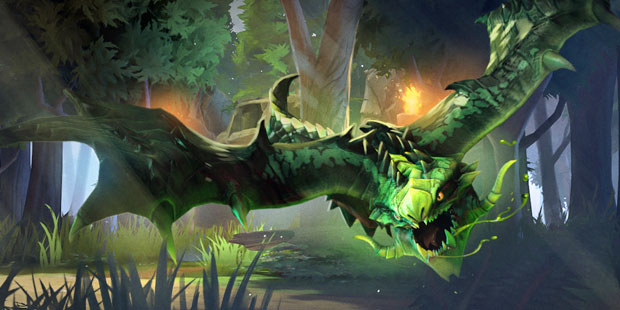How Valve’s Majors and Minors can heal pro Dota 2
Points win invites to win prizes!
With the biggest event in the competitive Dota 2 [official site] calendar – The International 2017 – due to take place next month, it might be a little early to start thinking about The International 2018. Unless, that is, you’re Valve, who have revealed a massive overhaul to how the entire next professional season will play out.
Here's an in-depth look at why these changes are so promising for the pro scene.
Under the current system, teams simply compete in various third-party tournaments and/or a select few Valve-sponsored Major events; in the 2016/2017 season’s case, the Boston and Kiev Majors. A couple of months before The International, Valve picks and chooses which teams will be directly invited (thus sparing them the regional qualifiers), based on their performances in previous tournaments. This is an extremely big deal, what with TI’s prestige and ludicrous prize pools [this year's is $20.3m at the time of writing - ed.], and direct invites are often seen by players as a goal second only to actually winning the thing.
In the new system, Valve is employing maths. Individual players will accumulate points by placing highly in tournaments (more on those in a moment). Events with larger monetary prize pools provide more points, and the teams with the highest combined scores will win the direct TI invites. Only the top three point-wealthiest players on a team will contribute to its total, to allow new players to enter the professional echelons mid-season without torpedoing their squad’s tally. Oh, and points given by tournament placements will scale the closer they are to TI.
That’s not the only big change, though. Instead of having two Valve Majors a year, Valve will sponsor and help manage a series of third-party Major and Minor tournaments, assuming they can meet various criteria: first, both types require LAN finals to be eligible for Valve’s cash. Second, they must offer a base prize pool of $500,000 to be classed as a Major and $150,000 to be classed as a Minor. Third, they’ll need to have at least one qualifier from each of the six Valve-specified regions: North America, South America, China, Southeast Asia, Europe and CIS. Major and Minors are the only tournaments that contribute points to the invite system, presumably so top teams can’t stomp through smaller semi-pro tournaments for an easy boost.
Frankly, it all seems like a rather good idea. At the very least it’s an improvement on how current and previous seasons have worked. Valve’s lack of transparency regarding direct invites to its events (both TI and the Majors) is both well-documented in the press and a consistent source of bemusement for fans; not only is the specific criteria for invite worthiness left a mystery beyond “doing well in tournaments and not breaking the roster lock rules” (more on the latter in a bit), but even the number of invited teams seems to change on a whim.
The 2015/2016 season was particularly chaotic in this regard, with twelve teams invited to the Manila Major and just six to The International 2016 two months later. Even pros appear left out of the loop – in Valve’s own True Sight documentary, Fnatic don’t find out they’ve been passed over for a Boston Major invite until they check the public blog post announcement themselves.
Watch from the 8 minute mark for that:
Now, the process is completely open. Even fans at home will be able to keep track of points totals via public leaderboards and, assuming the points scaling with prize pool/TI proximity is kept consistent, everyone will know who needs to win at which tournaments in order for them to claim an invite. Potentially, it could give Minor tournaments the same high stakes as Majors, should teams with narrowly separated totals come up against each other.
This restructuring isn’t just good for the sake of a few event invites, though. Done right, it could ensure the health of professional Dota 2 as a whole.
For starters, there’s the money. While event organisers haven’t been abandoning the game in droves, the all-eclipsing dominance of Valve’s TI and Major tournaments combined with dwindling methods for monetising smaller events contributed to a historically sparse 2016/2017 season, with fewer total top-tier events run by third parties. This is also worrying from a spectator standpoint, as appearances by the most elite teams can be weeks or months apart.
Valve opening up their sponsorship and managerial help to more than a couple of proposals a year could see organisers striking back. The added exposure of Major/Minor branding is surely an incentive to these viewer-hungry organisations, and having Valve essentially double the minimum prize pool must sound like a pretty good deal as well. More tournaments also means more points and cash prizes. More points and cash prizes mean more top-flight teams taking part, which means more entertaining matches and opportunities for storylines to develop. Literally everyone wins.
Speaking of participation, the attempt to standardise the system of six regional qualifiers per event is also something worth encouraging. Segmenting the qualifiers further than the current standard (which usually lumps North and South America together, and the same for Europe and CIS) is not only fairer, as it minimises the impact of ping disparities, but also makes it easier for up-and-coming teams to break out from typically overlooked regions. Brazilian team SG e-sports’ incredible Kiev Major run was a joy to watch, but it might never have happened had South America not had its own qualifier; instead, they’d have likely fallen to NA winners Digital Chaos in a combined ‘Americas’ qualifier.
The points mechanism could also help maintain competitiveness. Not to say that pros don’t bother so much for the rest of the year, but currently, the months leading up to TI are by far the most important in determining who receives the invites. A team could completely bomb throughout the autumn and winter, only to earn a ticket to the most important (and profitable) event of the year with one or two key wins in the spring. Since points will start accumulating from the very first Major or Minor, there’s the element of a league format, where every victory (or loss) counts towards the final outcome.
Of course, there’s still that added weighting of points from events that do take place shortly before TI, but even this ensures that teams must consistently perform at their best. Players can’t simply coast along on a good start to the season, what with the risk of rivals using those extra points to overtake them in the final stretch.
It’s too early to say how the fact that players earn points individually will affect their tendency to swap teams. It could be that high-scoring players will attempt to stick with their roster even if other factors (like personal chemistry or playstyle mismatches) might have led them to leave under the current system, or low-scoring players could be more eager than ever to jump ship now that their lack of progress towards TI can be quantified in such clear terms.
On this, we’ll have to see, but one thing that won’t be changing much is the roster lock system. There will still be specific periods where players can leave and join teams, taking their points score with them without penalties. However, Valve hasn’t detailed how long these periods will last, nor how often they’ll occur – once after every Major, as it is currently, seems like it could be too often for a stable scene if there are going to be more third-party Majors each season.
The penalties for switching registered players beyond the roster lock deadline also haven’t been revealed. Currently teams that break this rule are made ineligible for both direct invites and invites to regional qualifiers, but how would that work when invites are based on individual player performances, especially when two of a team’s five players don’t contribute to their group score anyway? Would the remaining players be removed from the running entirely? Would they still be eligible, but docked points? These are questions Valve will need to answer, especially since the post-TI7 shuffle is mere weeks away.
In fact, if there’s a general problem with all this Major/Minor/points stuff, it’s that Valve is clouding their newfound transparency with a lack of specifics in other areas. The missing roster lock rules are arguably the most crucial omission, but the announcement post’s slightly vague wording of “we will be selecting many third-party tournaments to directly sponsor” could mean a number of things, depending on your definition of “many”.
It could be that Valve will once again only hold two or three Majors, with Minors sprinkled among the gaps in between – or we could end up seeing a Major every other month. It’s not out of the question, considering that in 2017 alone we’ve already had four tournaments (WCA, DAC, The Kiev Major and Epicenter) which met the $500,000 prize pool requirement.
In any case, Valve will naturally want to continue curating which third parties can hold a sponsored event. That isn’t a bad thing in itself – Chinese firm Perfect World, for instance, were viewed with suspicion by fans even before helming the disastrous Shanghai Major in 2016, and although they clawed some respect back with a generally successful DAC 2017, it would be reassuring to know what measures Valve is taking to ensure the smooth running of what will become Dota 2’s tentpole tournaments. As yet, this information remains as opaque as the old TI invite criteria.
Still, absence of evidence is not evidence of rubbish video game contests. Valve still has some time to explain the intricacies of the new season, but to their credit, almost everything we do know about the revised system is either an inarguable improvement or has the clear potential to become one. All eyes may be on TI7 at the moment, but the year beyond is proving just as exciting.







